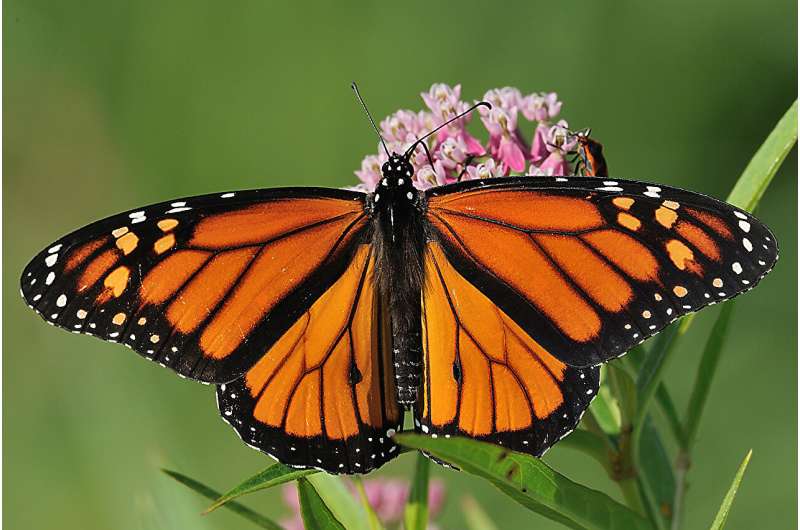This article has been reviewed according to Science X's editorial process and policies. Editors have highlighted the following attributes while ensuring the content's credibility:
fact-checked
peer-reviewed publication
trusted source
proofread
Research suggests monarch butterflies may be in less danger than we think

The migratory monarch butterfly might not be as endangered as previously thought, according to a new study published in Current Biology.
Humans may have artificially inflated the monarch population by making changes to the habitat of Eastern and North America. The numbers we see now may reflect an expanded population from precolonial sizes.
"This doesn't mean we shouldn't strive to have more pollinator-friendly habitats for monarchs and beneficial insects," said senior author Joshua Puzey, an associate professor in the William & Mary biology department.
The author group includes other current and past W&M biology affiliates, such as first author John Boyle, formerly Mellon Postdoctoral Fellow of Environmental Science and Policy, Associate Professor Harmony Dalgleish and Angela Ricono M.Sc. '18. Ron Smith, associate teaching professor of data science, is also a William & Mary co-author.
Examining evidence from the past century, previous research from Boyle, Dalgleish and Puzey had disproved that genetically modified crops were the main culprits for the decline of the monarch butterfly (Danaus plexippus) and its dominant food source, the common milkweed (Asclepias syriaca).
In this new paper, researchers widened their focus to the past 25,000 years. Using five different data sets, as well as sequenced DNA from milkweeds and monarchs, they tested several hypotheses using Approximate Bayesian Computation via Random Forests, a machine learning method for reconstructing demographic histories.
The researchers found that the numbers of milkweeds and monarchs increased after the last glacial period. Their hypothesis is that vast spaces had become available to both species when glaciers retreated.
Another increase was detected in the 18th and 19th centuries, when deforestation and expanded agricultural fields created beneficial conditions for the common milkweed in Eastern North America. "Milkweed plants love to grow in disturbed agricultural fields," said Puzey.
An abundance of milkweed is at least correlated to the monarch population growth. However, it is not necessarily its main driver.
"If you go out into nature during the migration to find milkweed, and you search the milkweed plants for monarch eggs or caterpillars, most of the time you can't find them," said Puzey. "If milkweed plants are truly the limiting resource, you would be expecting that monarchs would be competing for it."
According to Puzey, monarchs were originally only occupying the Great Plains and may have extended their migration eastwards because food resources had become available in the newly created habitat.
"Historically, the common milkweed might have been quite rare on the landscape of Eastern North America," said Puzey.
What the study did not detect was an effective population decline in both monarchs and milkweeds over the past 75 years, a period that corresponds to an expanded use of chemicals in agriculture. This reduction may have been either too small or too recent to leave a signal in the researchers' data set, but the easiest explanation, as the study suggests, is that it simply did not happen.
The decline observed over the past 40 years may reflect a mismatch between the monarch population that overwinters in Mexico and the species' effective population size. However, the authors reiterate that their study should not directly impact current conservation efforts.
"What I really like about the monarch is that it's a signal to the world that insects are a vital part of our ecosystem," said Puzey. "Their population can be fragile, and we need to be concerned with not only the macroscopic organisms but also the smallest living organisms."
The authors encourage further sampling and sequencing and welcome future improvements in demographic modeling techniques, which may shed new light on their interpretation.
According to Puzey, the study's hypothesis demonstrates that humans have a massive impact on the landscape. As an example, he cited cardinals, who are fond of that habitat between private yards and the woods: By creating more suburbs, humans have also created more habitat for cardinals.
"Just because what we see now is normal, it doesn't mean it was normal 400 years ago," he said. "What we see now is not necessarily what has always been, but we should focus our efforts in keeping things healthy and stable."
More information: John H. Boyle et al, Temporal matches between monarch butterfly and milkweed population changes over the past 25,000 years, Current Biology (2023). DOI: 10.1016/j.cub.2023.07.057
Journal information: Current Biology
Provided by The College of William & Mary


















